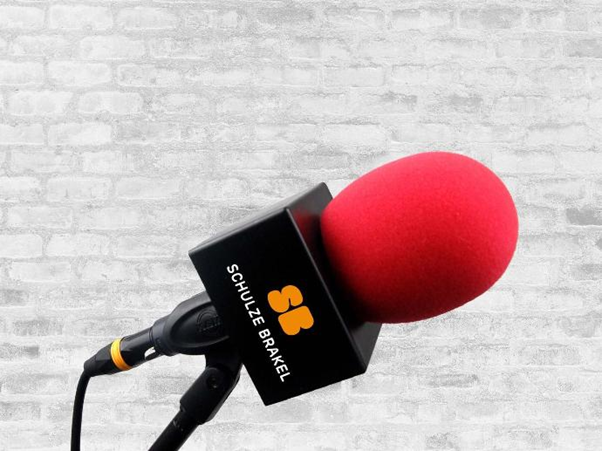Assorted Topics
Here you can find more information that might be interesting for you.
We all know the beautiful, colorful or furry microphone windscreens in television reports and film sets. But why do they exist? How were they invented? And what is the outstanding thing along the Schulze-Brakel windshields? In the following, we will answer all of this.
Sound waves interference through wind noise.
Wind noise and air movement are the biggest problems if you want to record audio outside. The wind sound makes a low rumbling, bass-heavy noise on the audio tape which is almost impossible to delete in later audio editing. Interrupting wind noise usually happen in the sub-500Hz range of the frequency spectrum.
This means it can damage the frequencies 85 Hz-265 Hz, which the human voice typically lies on. This causes dialogues to become completely unusable and unintelligible. To prevent wind noise from destroying audio recordings, it is recommended to use a windshield to protect the recordings to avoid wind interference.
This can be achieved by using a plastic, foam, fur, mesh, or fabric windshield. The windscreen creates a chamber around the microphone that shields it from all unwanted interrupting noises. Windscreens have different acoustic transparencies. Depending on the material, it will have a greater or lesser effect on the audio.
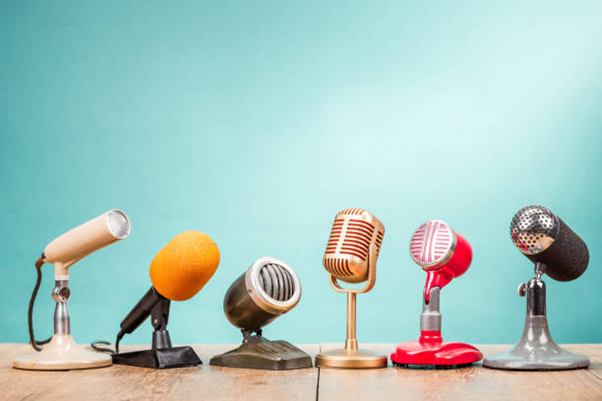
History of audio signals, the microphone, and their windshields
The history of the microphone is closely connected to the invention of the telephone. All began with Italian engineer Antonio Meucci, who developed a telephone based on an electromagnetic converter he invented in 1860. However, he was not granted a patent. Scottish deaf-mute teacher Alexander Graham Bell was working in the laboratory where Meucci's invention was stored, and filed a patent for a similarly technical device on 14th February 1876.
In the development of what he called the “Telephone”, Philipp Reis was the first to build a contact microphone, which he publicly presented as part of his telephone prototype in 1861. Based on the model of an earpiece, the German inventor recognized that a sound funnel covered with a membrane could be used instead of an eardrum. This sound funnel then led to a housing box.
He equipped the membrane with a platinum contact that barely touched another contact attached to the housing when at rest. Direct current was conducted through this contact and an external resistor. If there was now a sound exchange pressure on the membrane, it vibrated, causing the contacts to be pressed together more or less depending on the course of the sound waves.
With this experimental arrangement, Reis invented the contact microphone, from whose principle the carbon microphone was later developed and used in the early days of the radio for recordings.
Georg Neumann, a colleague of Reis, further developed the carbon microphone in 1923, which greatly improved the sound quality, particularly at low frequencies. However, he made a breakthrough with the development of the low-frequency (LF) capacitor microphone. The membrane and counter electrode from a capacitor that is charged with a DC voltage. The capacitor capacity changes with the movement of the membrane, from which the signal is obtained.
This transducer principle was far superior in quality to the sound recording technology of the time, and is still the standard for top-quality microphones today.
In 1928, Georg Neumann founded a company, Georg Neumann & Co KG in Berlin, to market his capacitor microphone, which is still one of the leading microphone manufacturers today. In an attempt to make sound recording better, the first windshields were developed and designed.
The first functional serial model, the Neumann CMV3, also known as the “Neumann bottle”, can be seen in many contemporary film recordings.
The first microphone with electrically switchable directional characteristics, the Neumann U47 of 1949, is also legendary and is still one of the most sought-after and expensive microphones today: a functional, well-preserved U47 is traded for around 5000 euros.
At first, stage actors and cabaret artists who now appeared on the radio found the microphone irritating. It was unusual to speak to a microphone instead of an audience. However, by the late 1920s, microphones were already sensitive enough that you didn't have to shout into them anymore.
In 1962, Gerhard M. Sessler and James Edward Maceo West invented the elected microphone, a variant of the capacitor microphone that is currently the most common microphone type with a 90% market share. Gerhard M. Sessler and Dietmar Hohm also invented the silicon microphone at TH Darmstadt in the 1980s.
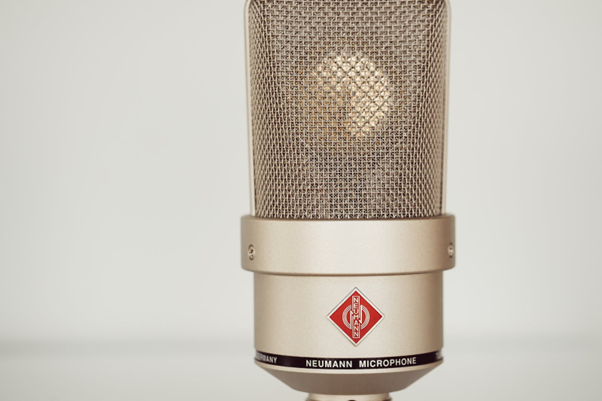
Schulze-Brakel wind noise reduction windshields
Microphone windshields have become the secret icons of the media world. Long, slender, small, round, four- or three-sided colorful, or furry microphone windscreens are recognizable for television interviews and news reports.
Windscreens serve as a tool of power because brands and channels are easily recognizable through them.
The foam wind deflectors on the microphones of television and radio stations tell an exciting story about the connection between design and society.
Actually, the wind deflectors are meant to prevent air noises at the microphone or at least make sure that this nasty popping noise is not heard that occurs when people pronounce sounds such as P impurely.
That's why some people don't call the wind deflector a wind deflector, but a pop or pop protector.
The German Schulze-Brakel Foam Processing GMBH is the world leading company for professional high-quality windshields for microphones. Today, the company maintains more than 50 foreign representations.
The competition comes from the UK, Turkey, and China. However, the original SchulzFoam© which can be applied to all Neumann microphones and other brands is unique.
There is this one problem with foam. Traditionally, you can dye it just once with a single color. For multicolored foams, you would need to dye two pieces and glue them together. But that does not look nice and is not a good solution. Schulze-Brakel engineers worked on it for a long time and wrote elaborate programs for their wind deflector machines. Instead of dying, Schulze-Brakel started with flocking.
The different layers of color are now sprayed on. Parts that are to be dipped in a second or third color are masked during this process. Flocking creates a soft, almost furry surface. Dyed models feel rough.
The final step in completion is attaching the transmitter logo. This is created using screen printing and is precisely attached using an iron and ruler
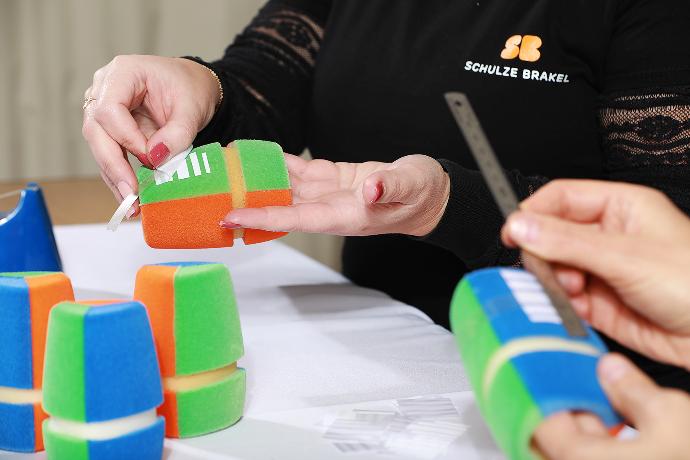
Everything is hand-made: an employee marks a microphone cover with a marker, cuts a foam block to size with a blade, and then shapes it on a model.
The company produces about 350,000 windshields per year. The price for a windshield is about three euros.
The high-quality models for outside broadcasting cost up to 20 euros. In the production hall, there are foam blocks in every color of the rainbow. The Schulze-Brakel employees work with the precision of surgeons.
In addition to the foam windshields, the company also produces microphone covers made of artificial leather and neoprene, which are used in rain or snow.
Schulze-Brakel is proud of the fact that they have the world's largest selection of windshields.
The company has about 400 models in stock. There are windshields in the shape of a heart, a star, a UFO, or a submarine. There are even windshields with a national Flag design.
Some broadcasters even commission special models for certain programs or correspondents.
In future, Schulze-Brakel would like to see a windshield with a built-in LED light on the market.
That would be a real innovation. Until then, the foam windshields will continue to be the stars in front of the camera.
FAQ
Why do microphones have foam around them?
The foam around microphones is called a windscreen. It protects the microphone from wind noise and air movement. Wind or breathing can cause loud pops in the audio signal.
When shall I use a windscreen?
Recording outside presents unpredictable circumstances. Weather can change, and it’s important to have the proper tools to overcome the obstacles that the outdoors may present. A windscreen is essential for recording outside.
Even indoors, wind can be an issue. Heating and air conditioning systems can create noise or people can cause air movement.
If you are recording indoors, place the microphone not near any source of forced air. You can use a foam windscreen as an insurance plan for unexpected winds that might occur indoors.
A windscreen is a device that is used to protect a microphone from wind noise and also from physical damage.
It is essential to use a windscreen if the microphone will be moved while in use, as wind moving past a stationary microphone is no different from a microphone moving through stationary air.
Windscreens are also effective in preventing “p-pops” in recordings, which are caused by the speaker speaking too closely to the microphone.
In addition to their primary function of reducing wind noise, windscreens also provide protection for microphones.
What types of windscreens exist?
1. Foam Windscreens
2. Synthetic Fur Wind guards or Windjammers
3. Baskets or Blimps
Which windscreen shall I choose?
1. Microphone Type and Size
In order to effectively reduce wind noise and protect your microphone, it is important to decide a windscreen that fits securely on the microphone and seals any potential leakage points. This will help to prevent air from disrupting the sound of the microphone.
Handheld microphones can typically be protected using universal foam windscreens, but be sure to check that the screen fully covers any ports or openings on the grill of the microphone.
It is possible to find universal windscreens that can be used on both large and small diaphragm condenser microphones.
2. Noise Attenuation
Attenuation, or noise reduction, is the most important factor. Directional microphones are susceptible to wind noise. For these reasons, you should decide for a fur windjammer or a basket when using a shotgun mic.
These will offer significantly more protection and ensure that the whole recording is not ruined.
3. Acoustic Transparency
There is a trade-off between noise attenuation and high frequency loss. Generally speaking, acoustic transparency will decrease with the addition of more layers.
When do I need to replace the microphone windscreen?
A windscreen is a protective cover for a microphone that helps to reduce wind noise and protect the microphone from physical damage.
However, over time, windscreens can become worn and dusty, and pieces of the windscreen may even find their way inside the microphone, potentially causing a malfunction.
Additionally, exposure to UV radiation can shorten the life of a windscreen. For these reasons, it is recommended to replace your microphone windscreen every few years in order to ensure optimal performance and protection for your microphone.
How do I need to clean the windscreen ?
To clean a foam windscreen, you can wash it in warm soapy water, rinse it in clean water, shake it to remove any water droplets, and then leave it to air dry overnight.
A clean windscreen not only looks better, but it also does a better job of keeping the grill of the microphone free from contaminants such as oils and dirt from the skin. It is important to keep your windscreen clean in order to maintain the best possible performance and appearance of your microphone.
Conclusion
The invention of microphones and their windscreens is closely related to the invention of the telephone. In the early 20th-century, wind protections were developed to conceal unwanted wind noise from the microphone diaphragm without losing high frequencies and still allowing sound waves to pass through.
Windscreens can be made out of Foam, synthetic fur or can come as a large static air chamber, which is placed around the microphone capsule. Foam windscreens protect the microphone before air movement indoors. Furry and dead air chamber windscreens are effective microphone wind protection outdoors.
It is also important to recognize what kind of microphone is used. For example, directional microphone are more sensitive than others. Schulze-Brakel is the world leading company in producing windscreens for television or film set microphones. With their unique technique and SchulzFoam© they can create multicolored microphone windscreens.
Windscreens for Microphones of certain Brands (Neumann, Rode, Sennheiser, Shure, Yellowtec)
Windscreens and pop filters help to reduce the pressure on a microphone's element from wind, as well as popping sounds from vocalizations. No matter the weather or location, Schulze-Brakel has a wind-damping solution for you. We offer foam windscreens, full-fur Deadcat solutions, and mesh pop screens to fit your needs.
As unbelievable as it sounds, there are nearly an inexhaustible number of choices for windscreens, just like there are types of microphones. Schulze-Brakel has them all--foam to PVC, in every color under the sun, and offered alone or in a pack. A fair amount of microphones come with some form of the pre-installed windscreen.
Even though some microphones come with a windscreen, it might not be enough to get rid of all the air noise. To protect further, add another windscreen outside the microphone around the capsule. Get yourself a SchulzFoam© windscreen that is formed for your specific microphone type; designed to eliminate air noise without interfering with audio quality.
Coloring different wedges in front of the mic can help a monitoring engineer quickly identify them. There are also windscreens designed for specific types of microphones and recording applications; like those furry ones often used with shotgun mics on video cameras, earning them the nickname 'deadcat'.
Unsure of which windscreen to purchase?
Look no further! Our Sales Engineers at
Schulze-Brakel have the most comprehensive knowledge about windscreens in the
market and will be more than happy to help you decide based on what type of
microphone you're working with as well as the conditions under which it'll be
used.
Condenser Microphone
A condenser microphone is a type of microphone that uses electrical capacitance to convert sound waves into audio signals. The term “condenser” refers to the capacitor in the microphone, which is responsible for converting the sound waves into electrical signals. Condenser microphones are typically used in recording studios, live music performances, and other professional audio applications.
Studio Microphone
A studio microphone is a specialized type of condenser microphone commonly used in recording studios, live music performances, and other professional audio applications. It is designed for capturing superior sound quality and accuracy compared to conventional microphones. Its design typically includes a large diaphragm, which helps capture subtle nuances in sound that may be missed or muffled by.
Cardioid Microphone
A cardioid microphone is a type of condenser microphone that is characterized by its unidirectional polar pattern. This means it is most sensitive to sound sources directly in front of the microphone, while rejecting sound coming from behind or off-axis. Cardioid microphones are especially beneficial in recordings where sounds from the surroundings need to be minimized.
Lavalier Microphone
A lavalier microphone, or lapel mic, is a type of small condenser microphone that is designed to be worn on the body. It typically clips onto the clothing of performers and speakers, allowing them to move around freely while still being close enough to capture the sound they produce. The lavalier microphone has become essential for capturing sound while activities.
Neumann
The TLM 102 microphone is a great choice for small studios. It offers Neumann quality at an affordable price, and it sounds great on vocals, guitars, and drums. The cardioid pattern and integrated pop screen make it easy to use, even for beginners.
The is designed and manufactured in Germany with attention to detail, and while it doesn't have all the features of more expensive models, the sound quality is brilliant.
The TLM 102 also has a very attractive look, with a gleaming chrome ring between a classic tapered head grille and the famous Neumann diamond.
The TLM 102 produces a clear and focused sound with superb definition, thanks to its newly developed large diaphragm condenser capsule. This allows it to capture the authentic character of any voice or instrument with enhanced silky highs around 10 kHz.
The TLM 102's technical capabilities are extremely impressive. Its self-noise is so low that it can scarcely be heard even in complete silence. It can also manage prolonged exposure to high decibel levels up to 144 dB without any distortion. The TLM 102 is one of the models in the TLM range, which means it has a transformerless output stage. This delivers rich bass tones and direct sound without any signal loss.
The TLM 102 is the perfect microphone for small studios! With its enormous dynamic range of 132 dB and uniform cardioid pickup pattern, it's easy to use for a variety of applications.
The Neumann KM 184 MT Compact Microphone has a genuine large diaphragm capsule that enables it to handle high SPLs without distortion. Additionally, its transformerless circuitry allows for gentle treble lift and silky highs while still maintaining very low self-noise levels.
The windscreen for Neumann microphone TLM 102 WS 7891 C is a specially designed round SchulzFoam© windscreen with best sound quality even for higher frequencies and has the best industry standard. The foam windscreen can be colored with strong colors and every slogan you want. Neumann won the Tec Award 2010.
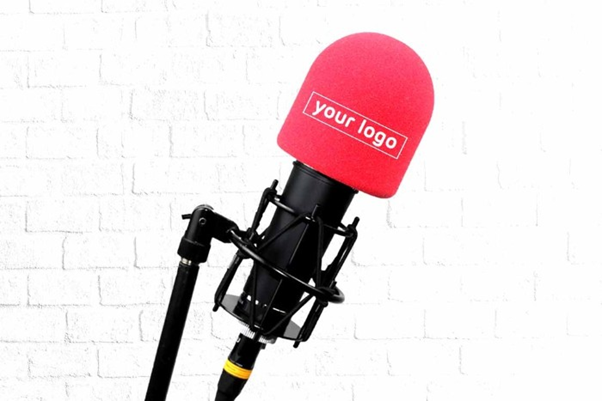

Rode
The Broadcaster is a top-of-the-line, battery powered, large diaphragm condenser microphone that excels in broadcast applications. Its frequency response has been specifically tuned for broadcasting, making it the perfect choice for recording arts and radio stations worldwide.
Additionally, its proximity effect allows for rich, controlled sound quality, and it features an internal pop filter to reduce plosives (hard “p” and “b” sounds) for short distances in speech or singing recordings, as well as a switchable 75 Hz high-pass filbroadcast-qualityone, features a broadcast quality capacitor for podcasting, radio production and voice-over.
The LED indicator lets you know when the recording is taking place, and it comes with a 10-year guarantee.
Schulze-Brakel offers an additional microphone windscreens for Rode Broadcaster WS 7891, Rode Wireless GO WS 7510 C, and Rode NTG 2 WS 9415C. The SchulzFoam© windscreens have the best sound quality even for higher frequencies and have the best recording industry standard. Each foam windscreen can be colored with strong colors and every slogan you want.
Sennheiser
The AVX-835 SET is the perfect wireless digital microphone set for your film projects. The system is self-configuring and ready to go in seconds. Its ultra-compact receiver can be directly connected to your camera or recorder's XLR audio input.
The rugged handheld transmitter is ideal for street interviews. The AVX-835 SET comes with the handheld microphone, plug-on receiver, and all necessary accessories to be up and running immediately—for camcorders as well as DSLR cameras.
Its digital signal transmission self-configures completely. This makes setting the transmission frequency a thing of the past. The ultraminiature receiver can rotate freely around its XLR connector so as not to obstruct other devices connected to the camera. The AVX automatically turns on and off with your camera to save battery power.
The AVX adapts its input sensitivity perfectly to that of your camera, so you don't have to separately adjust the audio level at the microphone. Whether you're shooting a professional wedding video or a company documentary, from street interviews to product videos – the AVX does its job well while allowing you to focus on being creative.
Schulze-Brakel offers a round SchulzFoam© Windscreen solution for Sennheiser AVX-835 WS 7033ö3 C.

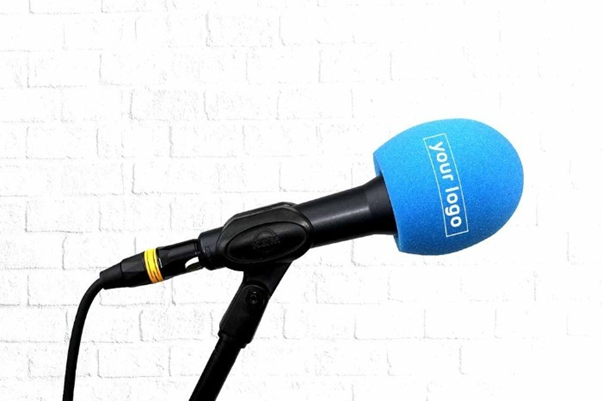
Shure
Since its initial release, the Beta® 58A has been used by some of the world's most powerful singers on some of the biggest stages worldwide. The Shure 58er is a top-class, dynamic vocal microphone that offers powerful, clear sound while suppressing background noise.
Its uniform supercardioid characteristic provides maximum feedback security, making it ideal for live performances where volume levels may be high. The neodymium magnet provides both high sensitivity and output level. The integrated, three-layer pop filter minimizes annoying breathing and wind noise, while the pneumatic shock absorber prevents impact noise with everyday handling abuse resistance due to its hardened steel basket construction.
The Beta 58A is a top-of-the-line vocal microphone perfect for use on any stage, big or small. Beloved by professional musicians and sound engineers, this mic excels in suppressing background noise and feedback while isolating the voice—all necessary factors to deliver an exceptional performance every time.
The Beta 58A sounds rich and present. It adds more detail to the typical Shure sound, particularly in the highs. Even without EQ settings on the mixing console, this microphone excels in a band mix.
The Beta 58A has a supercardioid characteristic, as opposed to the SM58's cardioid-- this means that it is way less likely to feedback. Additionally, the Beta's neodymium magnet is much more sensitive than the SM58's, so you'll get clearer highs with higher output levels. Plus, its hardened steel basket can withstand falls better too! Use a USB cord to connect the Beta 58A to your computer if you want to record digital audio straight onto your computer.
Schulze-Brakel offers windscreen solutions for Shure SM7, Shure SM 7B,Shure Beta 58A WS 9042 C and Shure SM58 WS 7510.
Yellowtec
This recording microphone is perfect for interviews. Its cardioid characteristic ensures a great recording level without any artifacts. The integrated LEA engine guarantees that the recordings will be free of levels or buffer issues. This product also has an AA battery life of up to 16 hours, making it super easy and fast to use!
Making your work a lot easier and letting your workplace design shine a little more – that's what Yellowtec stands for. Schulze-Brakel Windscreens for Yellowtec iXm and Yellowtec iXm WS 8423 are made out of SchulzFoam© and benefit the best quality recordings.
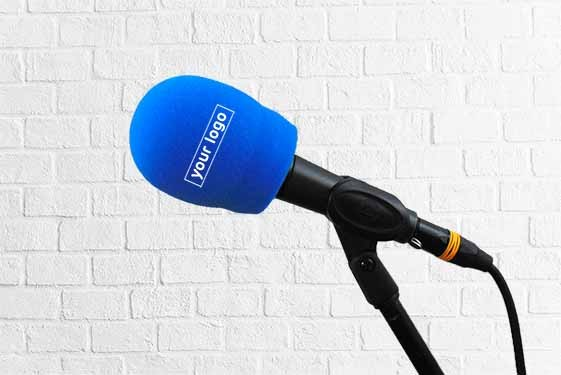
Conclusion
All the brands mentioned above produce exceptional recording microphones that are perfect for interviews, voice-overs, and other types of recordings. Each brand has its own unique features that make it stand out from the competition, but all of them share one common goal:
To provide customers with high-quality products that deliver great sound. Schulze-Brakel offers highly specified SchulzFoam© windscreens to reduce interrupting noise while also providing superior durability. If you're looking for a top-of-the-line windscreen for your recording microphone, Schulze-Brakel is your best choice.
How to conduct a journalistic interview: Interview techniques for journalists
While some journalists may claim that once you have learned how to
interview sources for writing articles, it will be a skill that you
possess for life, this is not necessarily accurate. Both new
journalists and experienced professionals have the potential to improve
their interviewing techniques in order to make their stories more
impactful.
But how to conduct a good interview as a journalist?
Conduct research on the topic and the subject you are covering.
To ensure a successful interview, it is vital to conduct research on the topic and the person you will be interviewing. Before securing the interview, familiarize yourself with the topic to make sure the interviewee is a suitable source.
It's not necessary to become an expert on the topic, but having a basic understanding allows you to ask informed questions to get better answers.
Additionally, researching your interviewee by looking at their online presence and past interviews can provide valuable information and help you tailor your questions accordingly.
Decide on the format for a successful interview.
In journalism school, it is generally taught that in-person interviews are the most ideal. However, in some cases, this may not be feasible or practical. Alternative options include video, phone or email interviews.
However, email interviews should be avoided when possible, as they can hinder the ability to develop a natural rapport with the interviewee and make it harder to ask follow-up questions.
When reaching out to the source, it's best to establish the method of interview, and if you don't have a preference, give the interviewee the choice. Once the method is decided, provide any necessary information such as an address, phone number or Zoom link.
If the interview is scheduled several days in advance, you can also send a calendar invite to ensure it's added to both your and their calendars. If the interview is conducted via Zoom, it's a good idea to include your phone number in case of any technical difficulties.
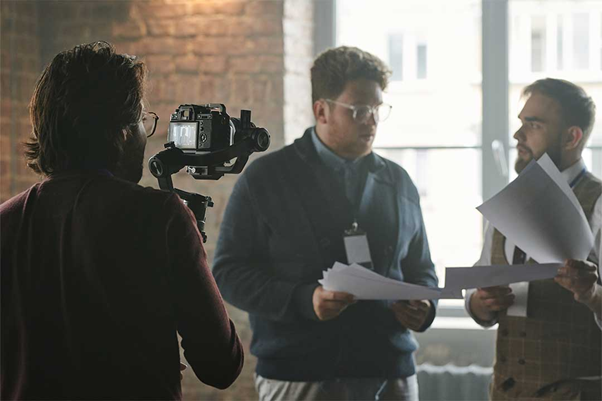

Establish clear expectations
When reaching out to a potential interviewee, it is important to set clear expectations by providing information about the purpose and focus of the interview. This will give the source an opportunity to consider the topic before the interview takes place.
However, it is not common practice to provide a list of questions in advance. Additionally, it is a good idea to give an estimated time for the interview, for example, “the interview should not take more than 45 minutes.” This will help prevent the interview from being cut short.
Finally, inform the source of any follow-up steps, such as a fact-checking process to ensure accuracy.
Think about the interview questions you will ask during the interview.
When conducting an interview, it is significant to have a list of key questions prepared in advance to ensure that you are able to gather all the necessary information for your story.
However, it is not ideal to read off a set list of questions during the interview. Here are some tips to keep in mind when formulating your questions:
● Ask open-ended questions rather than closed-ended questions, as they tend to elicit more detailed and informative responses. For example, instead of asking “Did you feel disappointed when you lost the election?” ask “How did you feel when you lost the election?”
● Request specific examples or numbers, as it helps to provide concrete evidence and make the story more engaging.
● End the interview by asking “Is there anything else important that we haven't covered?” as it allows the source to share any additional information or insights. Also, you can ask “Is there anyone else I should speak with about this?” which may lead you to your next interviewee.
Begin with the fundamental information.
At the beginning of the interview, it is essential to start with the basic questions.
This serves two purposes: to confirm basic information is accurate, and to make the interviewee feel more comfortable before delving into more in-depth questions.
Basic questions can include asking for the spelling of their name, confirming their job title and asking for clarification if necessary, the name of their company, and any other relevant background information.
Additionally, if the interviewee's age is relevant to the article, it is a good idea to ask for their birthday to ensure that the information remains accurate even if the article is published at a later date.
Pay attention and ask additional questions for clarification.
While having a set of prepared questions for an interview is important, it is also essential to talk freely, and be open to asking follow-up questions to gain additional information and insights.
Actively listen is crucial in this aspect, avoid getting distracted by typing or writing down everything that is being said. Recording the interview can be helpful as it allows you to focus on the conversation and take notes later on.
If you decide to record the interview, make sure to ask for the interviewee's permission and explain that it will help you to actively participate in the conversation.
Guide the conversation.
As the interviewer, you have the responsibility to guide the conversation and keep it focused.
Be aware of individuals who tend to digress from the topic and gently redirect the conversation back to the main purpose and intended questions.
If the conversation goes off track, remind the interviewee of the purpose of the interview and reiterate previous questions or move on to the next topic.
Avoid discussing your own personal information during the interview.
An interview is a conversation between two parties, but the main focus should be on the interviewee.
While it may be tempting to share personal anecdotes or opinions, it's best to refrain from doing so and instead keep the conversation focused on the interviewee's experiences and perspectives.
Building rapport is important, but it should not be at the expense of the main purpose of the interview, which is to gather information from the interviewee.
Pose difficult or sensitive questions.
As you establish a connection with the interviewee, and you got a few quotes, it may be tempting to avoid asking sensitive or difficult questions.
However, it is significant to remember that it is your responsibility as a journalist to pose these questions and challenge assumptions, and if they are a public official or politician, they are obligated to answer your inquiries.
Ask follow-up questions, rephrase and ask the same question again, and ask how they came to certain conclusions.
Your readers have a right to know the facts, and it is your duty to provide them with the information they need.
Be at ease with moments of silence.
Be comfortable with moments of silence during the interview.
Give the interviewee time to think after asking a challenging question, or even if they give a short answer, wait a few seconds before moving on to the next question.
This silence can help the interviewee to think more deeply and provide more detailed information or remember something they forgot.
Be mindful of their schedule and time constraints.
Be respectful of the interviewee's time constraints and be mindful of how long the interview is taking.
If it runs longer than expected, politely ask the interviewee if they have additional time to continue the conversation. If they don't, try to wrap up the interview or ask for the best way and time to follow up.
If necessary, you may be able to continue the conversation via text or email.
Express appreciation and thankfulness.
At the end of the interview, express gratitude and thank the interviewee for their time and willingness to participate in the interview.
This simple step can make a big difference in building a positive relationship with your sources.
Follow up Questions.
Before the great interview ends, ask the interviewee how they prefer to be contacted for follow-up questions or fact-checking.
Get their contact information, such as email or phone number, and make sure to provide them with your contact information as well. Encourage them to reach out to you if they think of anything else they'd like to include or share.
Once the article is published, follow up with the interviewee one more time and send them a link to the article via email. This is a great way to thank them again for their time, and they may also share the article on their social media channels.
Store their contact details for future reference.
If you've found a valuable source, make sure to save their contact information for future reference. Create a spreadsheet and save their name, contact information, area of expertise and contact preferences.
As you build your contacts, continue to expand this database. The Society of Professional Journalists has a helpful resource for finding expert sources in their Journalist’s Toolbox. This will be useful in the future when you need to find an expert to quote.
Do you have an interview tip that we didn't mention? Please tell us.
17 Tips for Decreasing Background Noise
Excessive background noise can detract from the listening experience and add to post-production difficulties. You may already be aware of this problem, either from a previous recording with unwanted background noise, or because you are concerned about future recordings. Whatever the reason, you've been looking for information on how to reduce background noise, and you've come to the right place.
It's important to note that when you use Schulze-Brakel windscreens, background noise is less of an issue when recording. Schulze-Brakel windscreens has the ability to enhance any recording, even those made in noisy environments, to sound like it was recorded in a professional podcasting studio.
Despite the benefits of studio sound, it's still useful to know how to reduce background noise when recording with a microphone. This will improve the overall audio quality, which will be appreciated during the editing process.
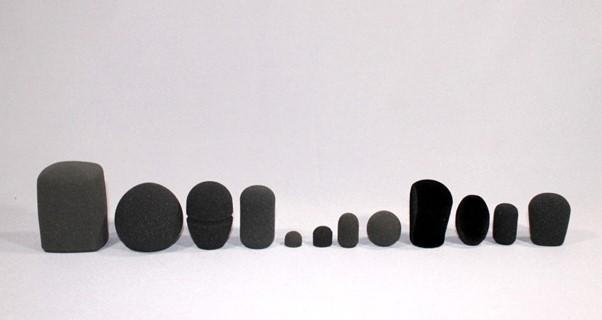
Identify the four main sources of background noise
To effectively reduce microphone noise, it's essential to be aware of the four types of noise that can affect your recordings. Understanding these sources will help you in your efforts to improve sound quality.
● Broadband background noise – Broadband noise: Broadband noise is a type of background noise that occurs over a wide range of frequencies, resulting in that familiar hiss or buzz.
● Narrowband background noise – Narrow band noise: Unlike broadband noise, narrowband noise impacts a limited range of frequencies. It can be caused by electrical circuit problems and results in a noticeable hum in audio recordings. Narrowband noise is often caused by issues such as ungrounded microphone cables or instrument pickups.
● Impulse background noise – Clicks and pops: Impulse noise refers to the category of background noise that includes the clicks and pops often heard in certain audio recordings. This type of noise can include plosives from consonants such as “p” and the sudden crackling sound produced when an audio cable is plugged in.
● Intermittent background noise: Irregular noise: Irregular noise, as the name suggests, occurs at random intervals and can include sounds such as rain, wind, thunder, traffic, and conversations that are present in the recording environment. This type of noise can come and go in unpredictable ways.
Reducing background noise during recording: 8 tips
Preventing unwanted background noise starts with blocking it during the recording process. While noise-cancelling software can be useful in post-production, a clean, noise-free recording is ideal in the first place. Here are six techniques for using audio hardware and recording techniques to achieve noise-free audio:
● Move the microphone closer. In podcasting, a recording where the speaker speaks directly into the microphone is called a “high speech-to-noise ratio”. To achieve this in your own podcasts, position the microphone close to the speaker's mouth – about a hand's length away. If the speaker is too far from the microphone, the sensitivity of the microphone will need to be increased, which will increase the noise level. On the other hand, a microphone with a lower sensitivity will pick up less background noise and reduce unwanted line noise.
● Find a stable microphone stand. Unwanted impulse noises may be coming from your old, wobbly microphone stand. To avoid this, use well-maintained stands and replace them if they start to produce unwanted noise. A shock mount clip for condenser microphones can also be used to hold the microphone off the stand and eliminate certain squeaks that may occur without the clip.
● Use a pop filter to eliminate plosives. A pop filter is a fabric screen that blocks the air puffs caused by certain consonants, particularly the “p” sound. Attach it to your microphone stand and position it between you and the microphone.
● In noisy environments, choose dynamic microphones. Both dynamic and condenser microphones have their advantages, but the typical dynamic microphone has a lower sensitivity than a typical condenser microphone. This makes dynamic microphones more suitable for noisy environments. By using a dynamic microphone and speaking close to it, you can improve your speech-to-noise ratio.
● Use clean electrical sources to avoid narrowband noise. Narrowband noise can be caused by electrical circuits and can cause hum in your audio recordings. This is particularly common in buildings with outdated electrical wiring and poor grounding, overloaded circuits, or odd wiring paths that create ground loop antennas. Avoid plugging audio equipment into the same outlet as high-powered lights, especially those with dimmer switches. You can solve this problem by using a power conditioner, which eliminates the AC ground loops that create narrowband noise.
● Record in the least noisy room available. To minimize background noise when recording, try to find the quietest room possible. For some people, this might be a closet, where clothes can help absorb sound. If you prefer to record from the comfort of your own home, minimize background noise by closing windows and doors, and use carpets to absorb sound.
● Check your plugs for possible problems. Faulty connections are often the cause of noise in your headphones. Check that all headphone jacks are securely plugged in. Repeat this procedure for your microphone inputs.
● Check the gain levels of your audio signal. The audio signal can be amplified in several stages to increase its volume. However, excessive gain applied near the beginning of the signal path can cause distortion. If your audio tracks sound noisy and distorted, reduce the volume, especially on the preamplifier if you're using one.
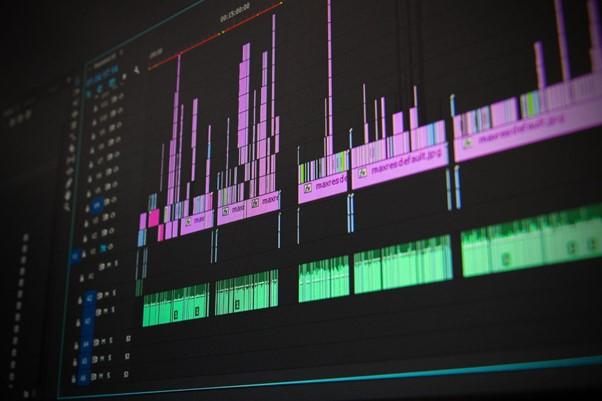
Ways to reduce noise on your computer
Your computer can play a crucial role in minimizing unwanted noise in your audio recordings. By using various software programs, you can improve your noisy audio recordings and turn them into a polished final product. Here are some of the ways you can use your computer to reduce noise:
● Reduce noise with Windows. Windows has built-in tools to help eliminate background noise. These can be found in the 'Hardware and Sound' section of your computer's Control Panel. Once there, go to the 'Recording' tab, select your recording device, and then select the device's 'Levels' tab. You can then reduce the microphone boost provided by Windows. Some computers also have an 'Enhancements' tab where you can enable the 'Noise Reduction' option.
● Use the tools built into macOS. Mac users can access the Sound section of System Preferences to adjust the input levels of your computer's audio devices. Older Mac models have an option for “ambient noise reduction”, but this feature is no longer available on newer Macs with Apple Silicon chips, such as the M1 chip.
● Use specialized noise reduction software. If you are recording audio directly on your computer, you can use software designed specifically to remove background noise during recording. One example is Krisp, which is available as a free version. It has features such as acoustic echo cancellation (to eliminate annoying echoes during video calls) and voice cancellation (to filter out all sounds except the main speaker's voice), making it useful for recording audio from video chats.
● Use the noise reduction features in your DAW. Most popular digital audio workstations (DAWs) offer tools for reducing unwanted noise in your mix. These tools can be found in programs such as Audacity, Adobe Audition, Pro Tools, Logic Pro and GarageBand. The process involves isolating the frequencies of the unwanted noise and then using a band-reject filter to eliminate those frequencies.
● Using manual audio filters is an alternative to using preset microphone noise reduction filters. By applying high-pass and low-pass filters to specific audio tracks, you can effectively eliminate ambient sounds that contribute to background noise. High-pass filters, also known as low-cut filters, allow high frequencies to pass through while filtering out low frequencies below a certain threshold. They are useful for eliminating low rumble sounds. Conversely, low-pass or high-cut filters allow low frequencies to pass while filtering out high frequencies above a certain threshold. These filters are effective in removing high ambient hum.
FAQ
What are the four main sources of background noise?
● Broadband background noise
● Narrowband background noise
● Impulse background noise
● Intermittent background noise
What are some techniques to reduce background noise during recording?
● Move the microphone closer to the talker
● Use a stable microphone stand
● Use a pop filter to remove plosives
● Use dynamic microphones in noisy environments
● Use clean electrical sources
● Record in the least noisy room
● Check your connectors for possible problems
● Check the gain of your audio signal
What role does your computer play in minimizing background noise?
You can use software to reduce background noise in audio recordings on your computer.
How does a Schulze-Brakel Windscreen help with background noise?
Schulze-Brakel windscreens have the ability to make any recording, even those made in noisy environments, sound like it was recorded in a professional podcasting studio.
Why is it important to reduce background noise in audio recordings?
Excessive
background noise detracts from the listening experience and makes
post-production more difficult. Reducing background noise improves the overall
audio quality of your recordings.
Conclusion
In summary, reducing background noise is essential to achieving clear, high-quality audio recordings. To minimize noise during recording, it's significant to understand the four main types of background noise – broadband, narrowband, impulse and intermittent – and to use the right hardware and techniques to prevent them.
To reduce
noise in post-production, use software to remove unwanted noise and improve
audio quality. By following these tips and using the right tools, you can
minimize unwanted background noise and achieve professional-sounding
recordings.
9+ Things to look for in a quality microphone windscreen
Recording
high-quality audio is essential for podcasters, YouTubers, musicians, sound
technicians, and filmmakers. A critical component of achieving this is having a
quality microphone windscreen.
A windscreen acts as a barrier against wind noise and handling noise, ensuring
that your recording is clear and free of unwanted sounds. However, with so many
windscreens on the market, it can be difficult to know which one is right for
you.
In this blog post, we'll be taking a closer look at the things you should be
looking for when choosing a microphone windscreen, to help you make an informed
decision and achieve professional-quality recordings every time.
FAQ: Choosing a
Microphone Windscreen
What material should I look for in a windscreen?
Look for a windscreen made of high-quality materials such as foam or fur that will effectively reduce wind and handling noise.
How do I ensure the windscreen fits my microphone properly?
Make sure the windscreen fits your microphone properly, without covering up the grille or affecting sound quality.
Why is breathability important in a windscreen?
Choose a windscreen with enough breathability to prevent your microphone from muffling your voice.
How durable should a windscreen be?
A good windscreen should be durable enough to withstand regular use and transport without falling apart or losing shape.
How do I ensure compatibility between my microphone and windscreen?
Ensure the windscreen is compatible with your microphone model, and fits snugly without slipping off during use.
What should I look for in terms of sound absorption?
Look for windscreens that effectively absorb wind noise and prevent it from impacting audio quality.
Is ease of use essential in a windscreen?
Yes, a quality windscreen should be easy to install and remove, allowing you to quickly switch between different microphone setups.
How should I consider the price of a windscreen?
Consider your budget and find a windscreen that offers the right balance of quality and affordability.
What should I look for in a brand when choosing a windscreen?
Select a windscreen from a reputable brand that has a proven track record of producing quality audio products.
Can customer reviews help me pick a windscreen?
Yes, reading customer reviews and
testimonials can give you a better idea of how well the windscreen performs in
real-world conditions.
Conclusion
In
conclusion, deciding the right windscreen for your microphone is crucial for
achieving optimal audio quality. The key factors to consider include material,
size, breathability, durability, compatibility, sound absorption, ease of use,
price, brand reputation, and customer reviews.
By taking these factors into account, you can find a windscreen that
effectively reduces wind and handling noise, fits your microphone properly, and
offers the right balance of quality and affordability. Remember to choose from
a reputable brand with a proven track record of producing quality audio
products, and don't hesitate to read customer reviews for real-world insight
into performance.
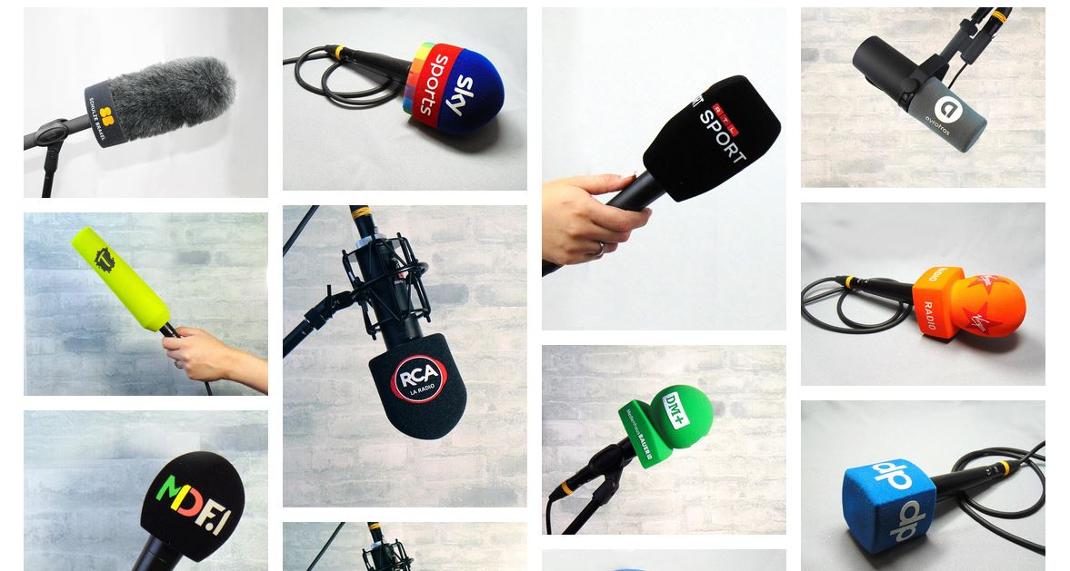
Windscreens for Smartphone
Microphones
Wind can be a relentless foe when it comes to recording quality audio or video. Whether you're capturing an outdoor show, streaming on Facebook Live from your backyard, conducting phone calls in blustery conditions or even driving with the windows down – wind interference will always leave its mark. The resulting noise and distortion can quickly ruin any project if left unchecked!
To ensure a clear audio quality both when recording and conversing on the phone, the most sensible solution is to use multi-layered windscreens that protect your smartphone's mic from gusts of wind.
Windscreens of this type are widely used to filter or reduce wind noise and protect audio recording machines and studio-grade microphones from wind interference.
Schulze-Brakel has just unveiled a revolutionary product that gives you access to the highest quality audio recordings for outdoor or adverse environmental conditions from your smartphone. Now, you can experience ideal sound on the go!
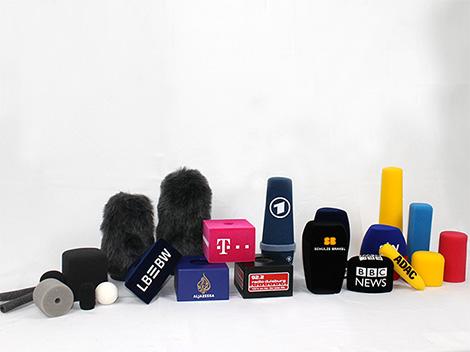
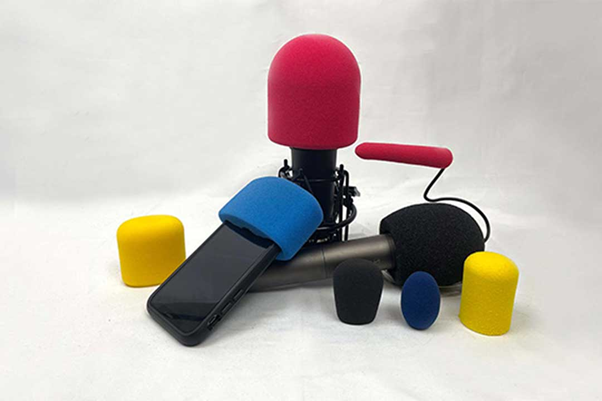
DESCRIPTION
● Wind noise can be reduced by up to 24 dB for clear record when using our product.
● Despite the highest frequencies being slightly lowered, their reduction is barely noticeable.
● Sponge foam technology is specially designed for acoustic layers, providing superior insulation and noise-cancellation capabilities.
● Constructed with superior safety and quality in mind, this product is crafted from certified materials within the European Union.
● With no risk of harm, our product is the simplest and most convenient way for you to attach it securely to your device.
● Not just shielding from the wind, but also safeguarding against dust and pollen – that's what this product is designed to do.
● Anything hand-crafted is a true masterpiece!
● Width 80 mm x height 60 mm x depth 42 mm
SAFE MATERIALS
To ensure the utmost safety, all materials used in this range of windscreens were sourced from within the EU. The synthetic leather material has even been certified to meet toy safety standards for infants and young children – yet, we strongly advise keeping these windscreens out of reach of both kids and pets.
MANUFACTURE
Schulze-Brakel prides themselves on producing outstanding windscreens, crafted with both technical precision and artisan skill. Every piece is created by hand using only the highest quality materials sourced from throughout Europe.
Note:
The stretchable, synthetic windscreen clings to the smartphone's body and acts as a barrier that soundproofs it from outside gusts.
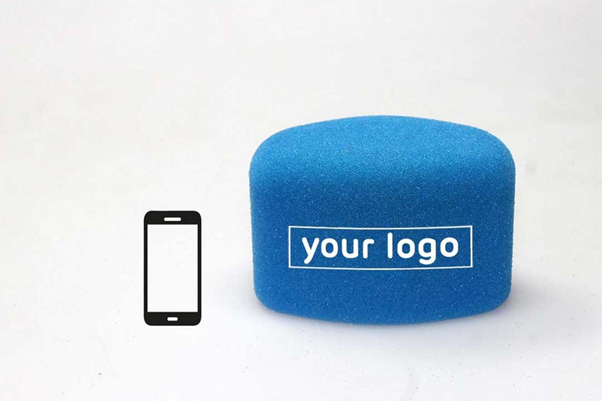
Conclusion
Our Windshield, Windscreens are specifically designed to reduce the wind noise interference at low frequencies that often occurs when using a microphone or camcorders. It can effectively block these noises without compromising any of its other features and functions, while also providing a great aesthetic look in multiple colors compatible with almost all Smartphones like iPhone or any Android! Our product is crafted from premium materials here in Germany for quality assurance – get your accessories today and send us your feedback!
If you are trying to record videos or audio clips outdoors on a windy day, you have probably experienced the issue of distorted sound due to the noise caused by gusts. Even light breezes can make for some pretty terrible recordings, especially when using a microphone without windshield. If you ask a professional in videography or sound editing, they will tell you that it is tough or maybe even impossible to remove wind noise after recording. The most practical and straightforward solution is therefore to use a windscreen.
There are many different types of windscreens, or wind muffs, available on the market today. They come in all shapes and sizes to fit different kinds of microphones. Although iPhone and GoPro have tiny muffs made specifically for their microphones, there are many bigger ones available for professional sound recording. Let's have a look at the various types of bigger windscreens for professional recording.
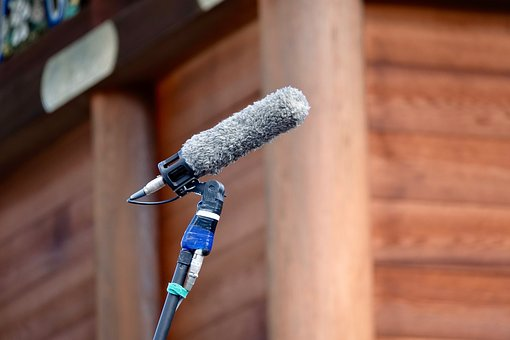
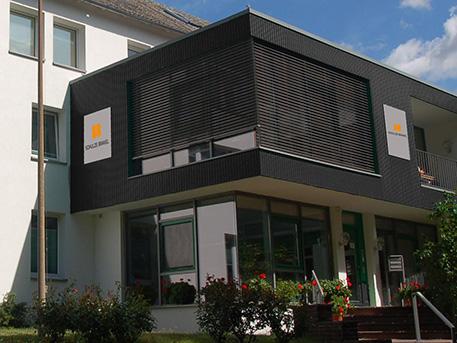
Dead Cat Microphone Covers:
Reducing wind noise without spending a lot
The dead cats use lightweight synthetic fur to block wind. However, no actual cats were harmed in the making of these products. But that nickname is because of their appearance. They only do look like dead animals. If you are trying to save money, this is the best option for you. The furry material blocks wind noise but does not affect how well your microphone picks up sound.
A dead cat with a foam windscreen can successfully block winds of up to 6 m/s, or about 13 mph. The most heavy-duty windscreen on the market is a microphone blimp, which gets its name from its pill-like shape. Dead cats are wrapped around the blimp, wich is a hollow cage that surrounds a shotun-microphone with an open chamber of still air, protecting them from vibrations caused by extreme weather conditions, like high winds. Deadcats are muffs that not only cover the mic head, but also enclose the microphone body to avoid sound distortion. Depending on your recording situation, it can be helpful to research the different types and differences in weight and material. Deadcat models vary a lot in recent years, often appearing much lighter than older versions. When you are ready to purchase a windcreen, make sure to keep those variables in mind so that you get one best-suited for your needs.
What Types of Deadcat microphone covers are there?
An advantage of using a dead cat as a microphone windscreen is that it features fake “fur.” By doing this, there is less wind noise pickup in the microphone than with other types of plain windscreens. Recording outdoors can be difficult because of frequently changing conditions, but these furry microphones are perfect for capturing clean audio in any environment.
There are two common types of "dead cats" that you might come across when recording audio. These two types are generally referred to as "dead cat" and "dead kitten". The dead cat, or furry sock, is a removable windscreen that helps to reduce noise.
When shooting film, there is the preference to use the zeppelin-style Blimp windscreen with microphone whenever possible.
Unlike foam windscreens, Deadcats provide excellent protection against the wind while remaining versatile to fit over many types of microphones. Fur windshields fit over different kinds of foam windshields or on wind cages for boom pole microphones. The strands of fur act as a wind baffle, which redirects the air flow. This method creates even less friction than stiff foam, and adds up to its effects, resulting in more noise being neutralised on its surface. Fur wind guards are significantly more effective than foam windscreens, in neutralizing wind noise, which are only offering 25dB-40dB of attenuation. By layering a deadcat over the top of the windscreen, up to 50dB of attenuation can be offered. It's crucial to only use high-quality products though, as low-quality fur windscreens can lead to adverse effects on sound quality. Typically, windscreens are designed to fit a specific model of microphone windscreen, but you can find some that will work with a range of microphone types.

Microphone Company Rode from Australia, calls them “dead wombats”
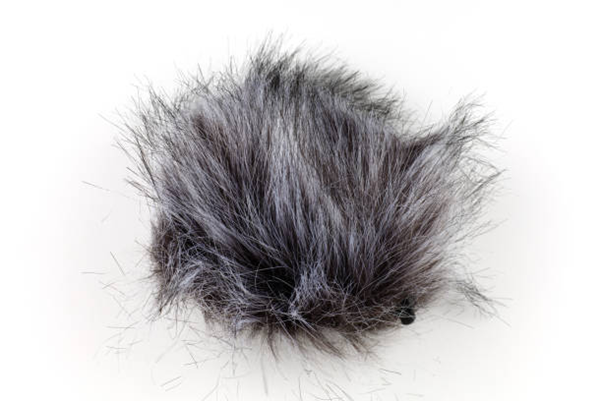
Dead kittens, or windjammers as they are more commonly referred to, are a smaller type of dead cat, that slips right onto the microphone foam filter. Windjammers are typically made of both synthetic fur and acoustic foam. The idea is to protect the capsule of the mic against wind noise by adding an extra layer of protection. You will often see windjammers in use on camera microphones or at the end of boom poles.
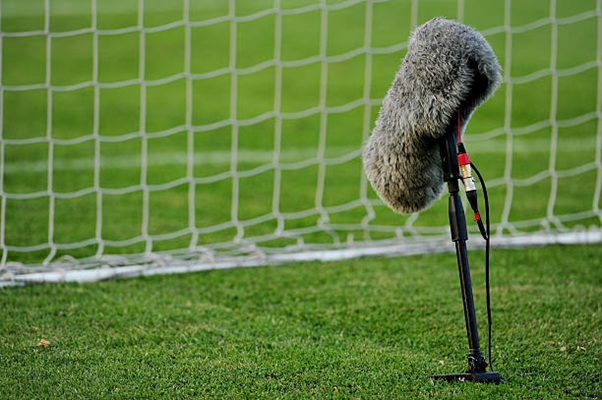
How often do I need to clean the windshield, and how?
You can clean it when necessary, or if it got dirty or wet during a shoot. You can wash it in warm soapy water, rinse with clean water, shake off any droplets and let it air dry overnight. A clean windscreen does a good job at keeping your microphone grill free of human contaminants, dust and dirt.
Deadcats have two layers, which help shield the microphone from unintentional noises. The inner layer is out of thin foam, which is covered by an outside layer of synthetic fur. This shall help to disperse the wind moving around the microphone, wich would cause noise on its surface, which can also lead to heavily distorted audio.
As longer the fur material is, as lesser air friction will be heard on the audio clip because the wind is allowed to move freely through the fur which neutralizes its kinetic energy. In contrast, shorter fur material will have a lesser reducing noise effect because there will be more wind friction around the microphone. Longer fur fibres allow winds to freely pass through and over the microphone with lesser resistance, because of the additional provided layer of noise protection, but without sacrificing a bit of high-frequencies in the signal. Usually, this will provide an air noise reduction of 25 dB with winds up to 6 meters per second.
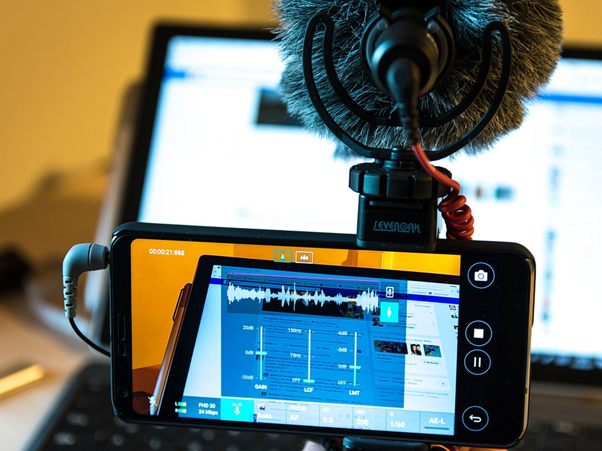
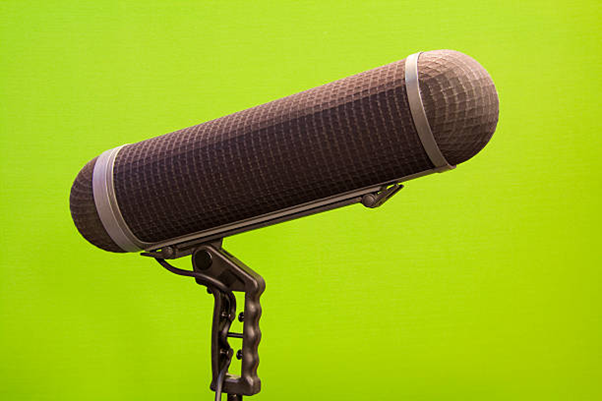
Some Deadcat windscreens are designed to slip over the blimp windscreens of shotgun-microphones.
The amount of wind protection video crews need, should be based on their location and the type of work they do. Crews that predominately work indoors will have different needs than those who record mostly outdoors in extreme conditions. In some indoor situations, it could still be useful to have a Deadcat in your bag to be accessible when needed.
Blimp windscreens are great at
reducing wind noise for many reasons
Blimp windscreens are essentially made from plastic mesh material, with a thin layer of foam inside the mesh. These will have a significantly larger circumference than the typical foam windscreen of a dead kitten-windjammer. Microphone grills are usually pill shaped, since they are construced as a cylinder with half ball ends. By encasing the microphone in a grill blimp, there is additional room for open-air movement which ultimately decreases wind noise. It protects the mic from wind of all directions. Most blimp windscreens have a shock mount to keep vibrations from reaching the microphone. The air in the oval space between the turbulent surfaces and the microphone reduces sound interference.

-
The Importance of Acoustic Transparency in Dead Cats
Acoustic
transparency is essential for your deadcat. Be sure to check the specifications of your deadcat, before you
purchase, to ensure it is acoustically transparent.
-
How Does Wind Interfere With A Microphone Signal?
There are two primary ways wind can adversely affect microphone performance:
Wind noise or sound caused by air movement. If this peak is elongated, it creates unnecessary noise in the lower frequencies and has the potential to overload the microphone preamplifier. This causes distortion, which actually leads to a destroyed signal, that can often not be restored.
As
stated before, if we are picking up wind noise in the microphone signal, that
is not ideal. To avoid capturing distorted
audio of gusts of air, we need to protect the microphone capsule from wind
exposure.
-
Does wind make noise if it does not hit objects?
No, it is the turbulence, which is caused by the wind hitting a surface, which is the source of all wind noise. The most common surface people hear wind against, is their ears. Dead cats have fur, which acts as an absorptive, moveable surface; when getting in contact with wind, the fur moves and absorbs its kinetic energy. This does reduce a huge amount of turbulence, compared to a hard, stationary surface.
The other crucial element worth mentioning, is the surface area. Traditional microphone windscreens have a solid piece of acoustic foam or woven nylon. The deadcat has numerous strands of soft fur. Therefore the total surface area is much more extensive and flexible. These tufts of fur essentially cause micro-turbulence and muffle sound waves silently.
So long as the dead cat is not flattened by gusts of wind or rain, it will be successful at reducing noise levels significantly. Of course, if the coat is sleek against either side – the microphone or exterior of its windshield – it will not be very effective in eliminating unwanted sounds caused by heavy winds.
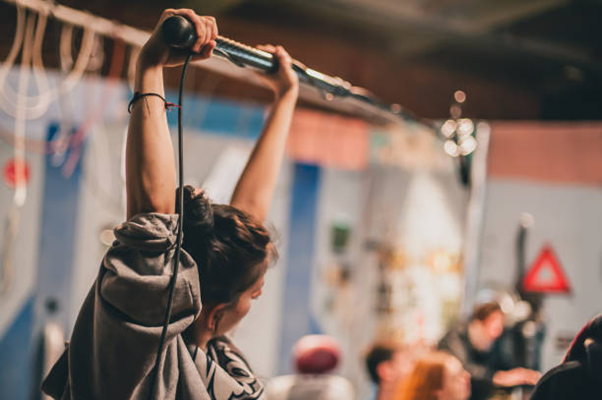
Why do I need to replace the microphone windscreen every few years?
The windscreen degrades with time through exposure to UV radiation, which can eventually cause dust and other particles to get inside the microphone and hinder its performance. It will lose its fluffiness over time by losing some fibres every now and then and by collecting dust, aerosol particles and dirt. This leads to a decrease in wind reduction and noise cancelling, which is why you should replace your fur windshield every few years, if you are using it regularly.
Conclusion
Windscreens are necessary to protect microphones from wind noise. They should be replaced every few years and cleaned as needed. Windscreens help reduce wind noise by creating micro-turbulence and dispersing sound waves. They also prevent dust and other particles from getting inside the microphone and harming its performance. Overall, windscreens are an important part of protecting your microphone and ensuring optimal performance. Be sure to check the specifications of any windscreen before you purchase to ensure it is acoustically transparent and made of high-quality materials. There are two types of microphone windscreens for windy weather. The Deadcat, which is made for long shotgun microphones and the smaller dead kittens or windjammers, which are just the smaller version of the Deadcat.

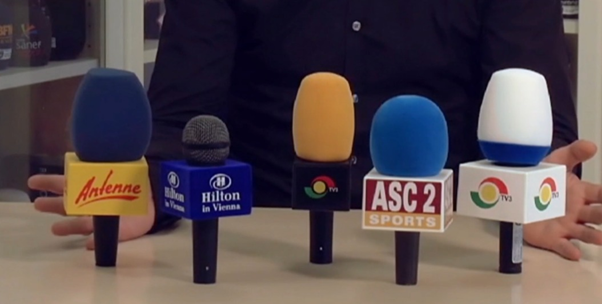
Microphone Flags are an important part of any audio equipment presentation. They provide a way for the audience to easily see and identify the microphones.
This is especially essential when there are many microphones on stage, as it can be difficult to tell them apart by sight alone.
Many types of microphone Flags are available, but the SchulzFoam Flag is a high-end option. It is made from durable foam material and features a bright, colorful logo that is easy to see from a distance.
This makes it an ideal choice for conferences, performances, and other events where visibility is significant.
What kind of different Mic
Flags are there?
There are a variety of different microphone Flags available on the market. Some of the most popular options include:

Fabric Flags
These Flags are made from lightweight fabric and are often decorated with a colorful logo or design. They are typically easy to see from a distance and are popular among performers and conference attendees.
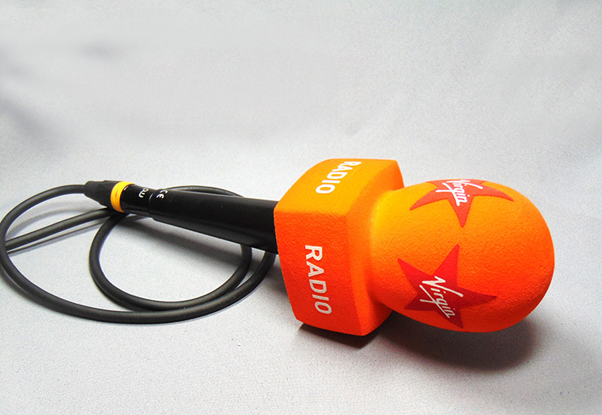
Schulz Foam Flags
Foam microphone Flags are durable and feature a brightly colored logo or design. They are ideal for visibility in large venues, and are a popular choice for conferences, performances, and other essential events.
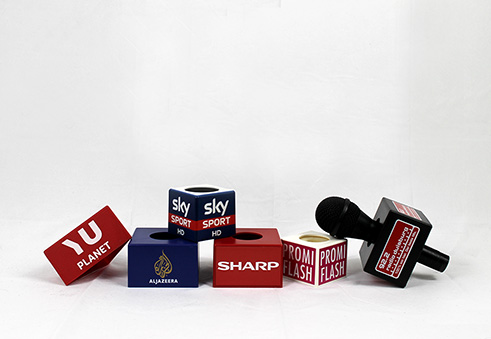
PVC Flags
Foam microphone Flags are durable and feature a brightly colored logo or design. They are ideal for visibility in large venues, and are a popular choice for conferences, performances, and other essential events.
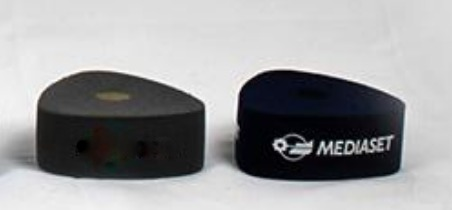
Blank microphone Flags or
custom mic Flags: two styles
You can choose to use a blank microphone Flag or a mic Flag that has been customized. A blank microphone flag is just a basic flag with no design on it.
A custom mic Flag is a Flag that has been customized to feature your company's logo or design. The custom mic Flag usually offers a four sided promotional space.
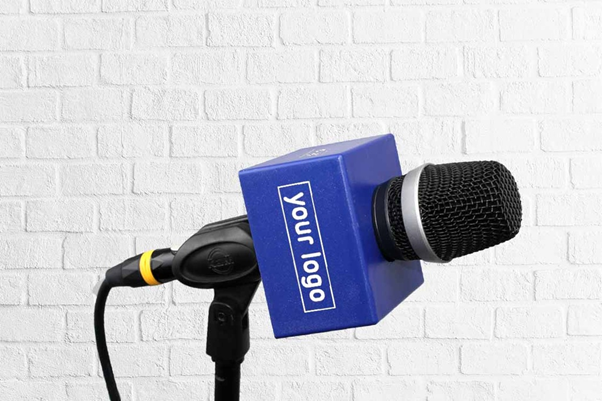
If you are looking for blank microphone Flags to create your own design, we offer a variety of colors and sizes in the best quality you can decide from.
Our products fit to virtually any microphone type and can be used for microphones that come with a conventional mic stand.
If you are looking for custom mic Flags with a specific design or logo, our Schulze-Brakel team can help to create the perfect customized Flag.
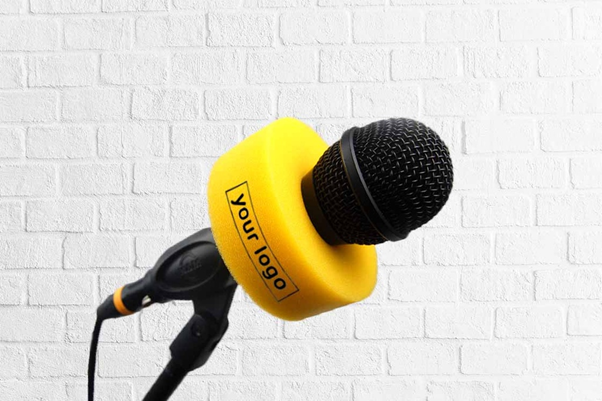
We use high-quality materials such as our own developed SchulzFoam and construction color printing techniques to ensure that your microphone Flag will stand out and look great.
Similar to our customized SchulzFoam Flags, you also can order printed foam windscreens for your microphone here: https://schulze-brakel gmbh.odoo.com/shop
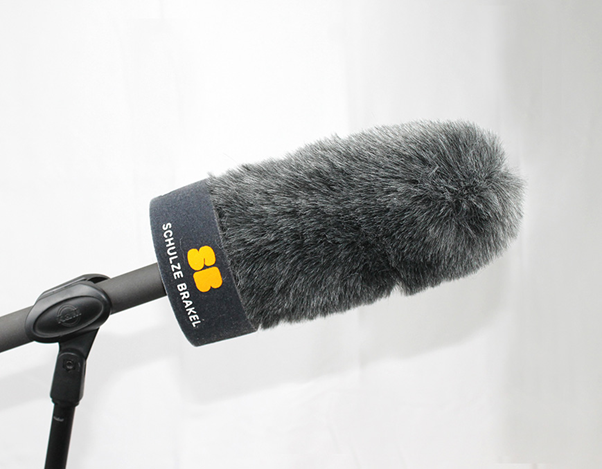
Further important information:
● Extra edge panels give the microphone Flag a finished look and make it more durable.
● A boom arm allows the microphone to be positioned conveniently for the user.
● Call letters and a web address can be added to the Flag to help identify the Flag's owner.
● An impact tower is a bigger Flag type that can be added to the microphone stand.
Conclusion
Microphone Flags are an
important part of any audio equipment presentation. They provide a way for the
audience to easily see and identify the microphones, which is especially
significant when there are many microphones on stage. There are a variety of different types of microphone flags available, but
the SchulzFoam flag is a high-end option that is made from durable foam
material and features a bright, colorful logo or design. The SchulzFoam flag is
a great way to add a touch of style and branding to your audio equipment
presentation. If you are looking for blank microphone Flags to create your
own design, we offer a variety of colors and sizes in the best quality you can
choose from. Our products fit to any microphone type. If you are looking for
custom mic Flags with a specific design or log, the Schulze-Brakel team can
help to create the perfect customized Flag for your audio equipment.
